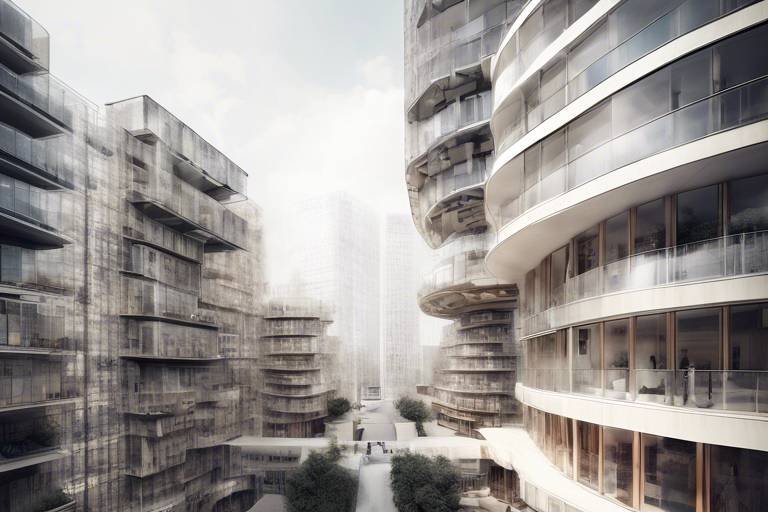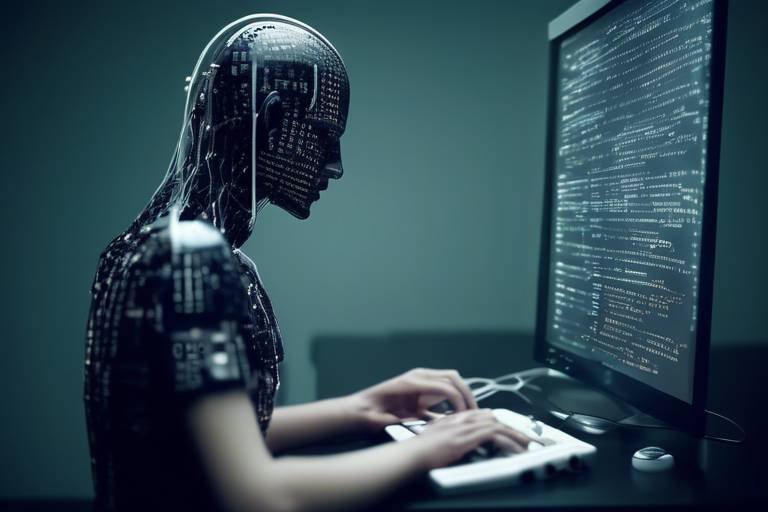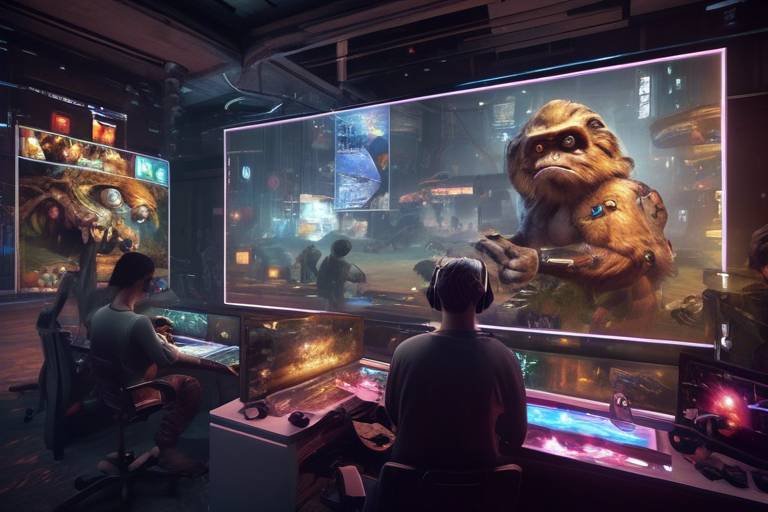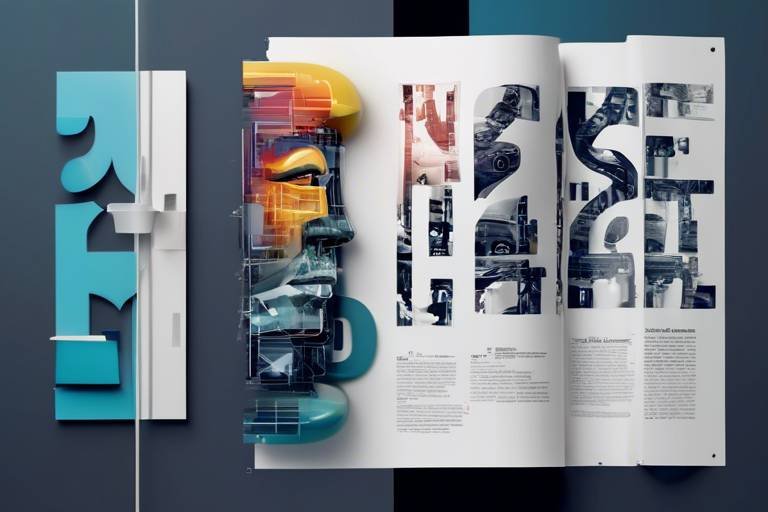Rethinking Architecture: Harnessing AI for Urban Design
In an age where technology permeates every facet of our lives, architecture is experiencing a transformative wave powered by artificial intelligence (AI). This intersection of AI and urban design is not just a trend; it's a revolution that promises to reshape our cities and the way we live in them. Imagine walking through a city where buildings are not only aesthetically pleasing but also designed for maximum efficiency, sustainability, and comfort. Sounds futuristic, right? Well, that future is unfolding right before our eyes.
As we dive deeper into this exciting realm, we’ll explore how AI is enhancing architectural practices, fostering sustainability, and ultimately improving urban living. From data-driven insights to innovative design tools, the potential of AI in urban planning is vast and varied. It's like having a supercharged assistant that can analyze mountains of data in seconds, helping architects and city planners make informed decisions that benefit both the environment and the community.
But what does this mean for the average person? Well, it could mean cleaner air, greener spaces, and buildings that adapt to their surroundings and the needs of their inhabitants. Picture your local park not only being a place to relax but also a hub of biodiversity, thanks to smart design choices informed by AI. This is not just about creating pretty buildings; it's about crafting a holistic urban experience that enhances quality of life.
Moreover, the integration of AI into urban design is paving the way for smart cities. These cities leverage real-time data to improve infrastructure, enhance public services, and engage citizens in the decision-making process. The result? Urban environments that are not only more livable but also more responsive to the needs of their residents. As we continue to explore this fascinating topic, we'll uncover the tools, challenges, and case studies that illustrate the profound impact of AI on architecture and urban design.
So, buckle up as we embark on this journey to rethink architecture through the lens of artificial intelligence. Whether you're an architect, a city planner, or simply a curious citizen, there's something here for everyone. Let’s dive into the specifics of how AI is revolutionizing urban planning and design.
AI is revolutionizing urban planning by providing data-driven insights that enhance decision-making processes, streamline project timelines, and optimize resource allocation for more sustainable cities. The power of AI lies in its ability to process and analyze vast amounts of data quickly, which is a game-changer in an industry that often relies on traditional methods and historical data.
Various AI-driven design tools are emerging, enabling architects to create more efficient and innovative building designs, reducing human error and enhancing creativity in the architectural process. These tools can analyze design options, predict outcomes, and even suggest improvements, making the design phase not just easier but also more exciting.
Generative design uses algorithms to explore a vast array of design options, allowing architects to discover optimal solutions that meet specific performance criteria and aesthetic goals. Imagine having a design partner that can brainstorm thousands of ideas in the blink of an eye—this is the power of generative design.
Examining real-world applications of generative design showcases its potential to create unique, functional spaces while minimizing material waste and maximizing energy efficiency. For instance, some architects have utilized generative design to create structures that not only fulfill their intended purpose but do so in a way that respects the environment.
Despite its benefits, the adoption of generative design presents challenges, such as the need for training and the integration of new technologies into traditional design workflows. It’s not just about having the tools; it’s about knowing how to use them effectively.
AI technologies are crucial for promoting sustainability in architecture by optimizing energy use, reducing carbon footprints, and facilitating the design of eco-friendly buildings. These advancements are not just beneficial; they are necessary for ensuring a sustainable future.
The concept of smart cities relies heavily on AI integration, enabling real-time data analysis, improved infrastructure management, and enhanced citizen engagement in urban environments. This integration creates a feedback loop where data informs design, which in turn improves the quality of life for residents.
AI enables city planners to make informed decisions based on data analysis, leading to more efficient urban designs that cater to the needs of the population. It’s like having a crystal ball that shows what the community needs before they even know it.
Implementing smart city initiatives involves addressing various challenges, including data privacy concerns, technological disparities, and the need for interdisciplinary collaboration among stakeholders. These hurdles must be navigated carefully to ensure that the benefits of smart cities are realized without compromising the trust of the citizens they serve.
- What is generative design? Generative design is a design exploration process that uses algorithms to generate a wide range of design alternatives based on user-defined goals.
- How can AI contribute to sustainability in architecture? AI can optimize energy use, reduce waste, and help design eco-friendly buildings by analyzing data and predicting outcomes.
- What are the main challenges of implementing AI in urban planning? Key challenges include data privacy issues, the need for training, and integrating new technologies with traditional practices.

The Role of AI in Urban Planning
Artificial Intelligence (AI) is not just a buzzword; it's a game-changer in the realm of urban planning. Imagine a city where every decision is backed by data, where resources are allocated efficiently, and where sustainability is not just an afterthought but a primary goal. This is the promise that AI holds for urban planning. By harnessing the power of data-driven insights, city planners can make informed choices that enhance the livability of urban spaces.
One of the most significant advantages of AI in urban planning is its ability to process vast amounts of data quickly and accurately. Traditional planning methods often rely on historical data and subjective assessments, which can lead to inefficiencies and missed opportunities. However, with AI, planners can analyze real-time data—such as traffic patterns, demographic shifts, and environmental changes—to make proactive decisions. For example, if traffic data indicates a growing congestion in a particular area, AI can suggest optimal routes for public transportation or recommend new road constructions to alleviate the issue.
Moreover, AI can streamline project timelines by automating routine tasks and providing predictive analytics. This means that urban planners can focus more on creative problem-solving rather than getting bogged down by administrative work. By using AI tools, planners can visualize potential outcomes of their projects, allowing them to adjust strategies before implementation.
Consider the benefits of using AI in resource allocation. In many cities, funds are limited, and prioritizing projects is crucial. AI can analyze various factors—like community needs, environmental impact, and cost-effectiveness—to suggest which projects should take precedence. This not only optimizes the use of resources but also ensures that the most pressing issues are addressed first, leading to a more responsive urban environment.
However, it's important to note that while AI brings numerous advantages, it also requires a shift in mindset among urban planners. Embracing these technologies means adapting to new workflows and understanding the intricacies of AI systems. Training and education will be vital to ensure that planners can leverage these tools effectively.
In summary, the role of AI in urban planning is multifaceted and transformative. By providing data-driven insights, streamlining processes, and optimizing resource allocation, AI is paving the way for more sustainable and efficient cities. As we continue to explore this innovative intersection, the possibilities for enhancing urban living are truly exciting.

AI-Driven Design Tools
In today's rapidly evolving architectural landscape, are emerging as game-changers. These innovative technologies are not just enhancing the way architects approach their projects; they are fundamentally reshaping the entire design process. Imagine having a digital assistant that can analyze countless design possibilities in mere seconds, helping you make informed decisions that would take traditional methods weeks or even months. This is the power of AI in architecture, where creativity meets computational prowess.
AI tools are designed to assist architects in a variety of ways. They can analyze existing structures, assess environmental impacts, and even simulate how a building will perform under various conditions. For instance, tools like Autodesk's Generative Design allow architects to input specific parameters—such as materials, budget, and spatial requirements—and then generate a multitude of design options that meet those criteria. This not only saves time but also opens the door to creative solutions that might not have been considered otherwise.
Moreover, these tools are not just about efficiency; they also enhance creativity. By eliminating the mundane aspects of design, architects can focus on what they do best—innovating and creating. The integration of AI in design encourages a collaborative atmosphere where human intuition and machine intelligence work hand in hand. For example, when using AI-driven tools, architects can explore generative design techniques that allow them to visualize and iterate on numerous design alternatives quickly. This process can lead to unexpected and exciting outcomes, much like a brainstorming session where every idea, big or small, is given a chance to shine.
However, the implementation of these tools is not without its challenges. Architects must adapt to new workflows and invest time in learning how to harness these technologies effectively. There is a learning curve associated with integrating AI into traditional practices, but the potential rewards are substantial. The ability to create designs that are not only aesthetically pleasing but also functional and sustainable is worth the effort.
To illustrate the impact of AI-driven design tools, consider the following table that highlights some of the most popular tools available today:
| Tool Name | Functionality | Benefits |
|---|---|---|
| Autodesk Generative Design | Generates multiple design alternatives based on input parameters. | Increases creativity, reduces time spent on iterations. |
| Spacemaker | AI tool for urban design and site planning. | Optimizes land use and enhances site analysis. |
| TestFit | Automates the design of residential and commercial buildings. | Speeds up the feasibility study process. |
As we move forward, the integration of AI-driven design tools will undoubtedly become more prevalent in architectural practices. They provide a unique opportunity to rethink how we approach design challenges and create spaces that are not only visually stunning but also environmentally responsible. The future of architecture lies in the synergy between human creativity and artificial intelligence, paving the way for a new era of innovative urban design.
- What are AI-driven design tools? These are software applications that utilize artificial intelligence to assist architects in generating and evaluating design options more efficiently.
- How do these tools enhance creativity? By automating routine tasks, AI tools allow architects to focus on innovative aspects of design, leading to more creative outcomes.
- Are there challenges in using AI-driven design tools? Yes, architects may face a learning curve and need to adapt their workflows to incorporate these new technologies effectively.

Generative Design Techniques
Generative design is an exciting frontier in architecture, where creativity meets computational power. Imagine an architect sitting at their computer, not just sketching out ideas, but engaging in a dialogue with an intelligent system that can produce countless design variations in mere moments. This technique leverages algorithms to explore a multitude of design options, pushing the boundaries of what is possible in architectural innovation. By inputting specific parameters such as materials, dimensions, and environmental considerations, architects can let the software generate designs that meet these criteria, often revealing solutions that may not have been considered initially.
The beauty of generative design lies in its ability to balance **aesthetics** and **functionality**. For instance, an architect might need a building to withstand high winds while also maximizing natural light. With generative design, the software can analyze various shapes and configurations, presenting the architect with several options that fulfill both requirements. This not only enhances creativity but also minimizes the risk of human error, as the system can quickly assess which designs are most effective based on real-world data.
Furthermore, generative design is not just about creating visually stunning buildings; it also plays a critical role in sustainability. By optimizing material usage and energy efficiency, architects can design structures that are not only beautiful but also environmentally friendly. For example, a generative design tool might suggest a building shape that uses less material while maintaining structural integrity, thereby reducing waste. This aligns perfectly with the growing demand for sustainable architecture, where every decision counts towards reducing our carbon footprint.
To illustrate the impact of generative design, consider the following table that highlights some key benefits:
| Benefit | Description |
|---|---|
| Enhanced Creativity | Generative design allows architects to explore a vast array of design possibilities, fostering innovation. |
| Increased Efficiency | By automating the design process, architects can save time and focus on refining concepts. |
| Sustainability | Generative design optimizes material usage, contributing to eco-friendly building practices. |
| Data-Driven Insights | Utilizing real-world data enables architects to make informed design decisions based on performance metrics. |
Despite its potential, the implementation of generative design is not without challenges. Architects must be willing to embrace new technologies and adapt their workflows, which can be daunting for those accustomed to traditional methods. Moreover, there is a learning curve associated with mastering these advanced tools, requiring training and practice. However, as the industry evolves, the benefits of generative design are becoming increasingly evident, paving the way for a future where architecture is more innovative, sustainable, and responsive to the needs of society.
- What is generative design? Generative design is a design process that uses algorithms to generate a multitude of design alternatives based on specified parameters.
- How does generative design improve sustainability? By optimizing material usage and energy efficiency, generative design helps create buildings that have a lower environmental impact.
- Is generative design accessible to all architects? While it requires some training and familiarity with advanced software, many tools are becoming more user-friendly, making them accessible to a wider range of architects.
- Can generative design be used for all types of buildings? Yes, generative design can be applied to various building types, from residential homes to large commercial structures, adapting to specific needs and constraints.

Case Studies in Generative Design
Generative design has emerged as a groundbreaking approach in architecture, showcasing its potential through various real-world applications. One of the most notable examples is the AI-generated design of the Autodesk's 'The Living' studio, which utilized generative design to create a stunning pavilion for the 2016 SXSW Festival. This project not only exemplified creativity but also emphasized efficiency, as the design process was significantly expedited through the use of advanced algorithms. By inputting specific parameters—such as material types, structural requirements, and environmental conditions—the AI was able to generate a multitude of design options, leading to a final structure that was both visually striking and structurally sound.
Another compelling case study is the AI-assisted design of the 'Hannover 4.0' project in Germany. This initiative aimed to revitalize urban spaces while considering sustainability and community needs. By employing generative design techniques, the architects were able to explore various layouts and building forms that enhanced social interaction and green space integration. The result was a harmonious blend of architecture and nature, where the buildings not only served functional purposes but also contributed to the overall well-being of the residents.
Furthermore, the Google Sidewalk Labs project in Toronto is an ambitious endeavor that integrates generative design principles. The project aims to create a smart, sustainable urban environment by utilizing AI to analyze data from community needs and environmental factors. Through generative design, Sidewalk Labs is exploring innovative solutions for public spaces, transportation systems, and energy-efficient buildings. This approach illustrates how generative design can lead to a more responsive and adaptive urban landscape that prioritizes the needs of its inhabitants.
Despite the impressive outcomes of these case studies, the journey of implementing generative design is not without its challenges. Architects and designers often face obstacles such as the steep learning curve associated with new technology and the need to integrate these advanced tools into existing workflows. However, the benefits—ranging from reduced material waste to enhanced creativity—far outweigh the hurdles. As the industry continues to embrace AI-driven methodologies, the potential for generative design to revolutionize urban architecture is limitless.
- What is generative design? Generative design is an iterative design process that uses algorithms to generate a wide range of design alternatives based on specific input parameters.
- How does AI enhance architectural design? AI enhances architectural design by providing data-driven insights, streamlining workflows, and allowing for more innovative and efficient design solutions.
- What are the benefits of using generative design in urban planning? The benefits include reduced material waste, improved energy efficiency, and the ability to explore a multitude of design options quickly.
- Are there any challenges in adopting generative design? Yes, challenges include the need for training, integration with existing practices, and potential resistance to change within the architectural community.

Challenges of Implementing Generative Design
While generative design offers a treasure trove of possibilities for architects and urban planners, its implementation isn't without hurdles. One of the most significant challenges lies in the need for specialized training. Architects accustomed to traditional design methods may find themselves in a steep learning curve when introduced to generative algorithms and software. It’s like asking a seasoned painter to suddenly master digital art; the tools may be different, but the creative essence remains.
Moreover, integrating generative design into existing workflows can be a daunting task. Many firms have established processes that have worked for years, and the thought of overhauling these systems to accommodate new technology can be overwhelming. The transition requires not just new software, but also a cultural shift within the organization. Employees need to embrace a mindset that values experimentation and flexibility, which can be a tough sell in a field often dominated by rigid standards and practices.
Another challenge is the collaboration between various stakeholders involved in a project. Generative design relies heavily on data input from multiple sources, including engineers, environmental scientists, and urban planners. Coordinating these inputs can sometimes feel like herding cats. Each discipline has its own language and priorities, and aligning these can lead to miscommunication and delays. However, overcoming these barriers is essential for unlocking the full potential of generative design.
Additionally, there’s the concern of computational power and resources. Generative design can require extensive processing capabilities to explore vast design options. Not all firms have access to the necessary technology, which can create disparities in who can leverage this innovative approach. This is particularly pertinent for smaller firms or those in developing regions, where resources may be limited.
In summary, while the benefits of generative design are compelling, the path to its adoption is fraught with challenges. From training and workflow integration to collaboration and resource allocation, overcoming these obstacles will require concerted effort and a willingness to adapt. However, those who successfully navigate this landscape may find themselves at the forefront of a new era in architecture, where creativity and technology converge in unprecedented ways.
- What is generative design?
Generative design is an iterative design process that uses algorithms to generate a wide range of design alternatives based on specified parameters and constraints. - How does generative design enhance sustainability?
By optimizing material usage and energy efficiency, generative design can lead to the creation of buildings that have a smaller environmental footprint. - What skills are needed to implement generative design?
Skills in programming, data analysis, and familiarity with design software are essential for effectively utilizing generative design techniques. - Can small firms benefit from generative design?
Yes, while it may require investment in technology and training, small firms can leverage generative design to create innovative solutions that stand out in the market.

AI for Sustainability in Architecture
In today's world, where environmental challenges loom larger than ever, the role of artificial intelligence (AI) in promoting sustainability within architecture is nothing short of revolutionary. Imagine a world where buildings not only serve their inhabitants but also coexist harmoniously with the environment. AI technologies are paving the way for this vision by optimizing energy use, reducing carbon footprints, and facilitating the design of eco-friendly structures. But how does this all work?
At its core, AI leverages vast amounts of data to inform architectural decisions. For instance, AI can analyze weather patterns, energy consumption data, and even the geographical layout of a site to suggest the most efficient building designs. This data-driven approach allows architects to create spaces that are not only aesthetically pleasing but also environmentally responsible.
One of the most exciting aspects of AI in architecture is its ability to simulate various environmental scenarios. By using predictive modeling, architects can foresee how a building will perform under different conditions. This means they can make informed choices about materials, energy systems, and overall design long before construction begins. For example, AI can help determine the optimal placement of windows to maximize natural light while minimizing heat loss, thus reducing the need for artificial lighting and heating.
Moreover, AI can assist in the lifecycle management of buildings. From the initial design phase to maintenance and eventual demolition, AI tools can track a building's energy usage and environmental impact. This continuous monitoring allows for timely interventions to improve performance and sustainability. For instance, an AI system can alert facility managers about unusual spikes in energy consumption, prompting them to investigate and address potential issues before they escalate.
However, the journey towards sustainable architecture through AI is not without its challenges. Integrating AI into traditional architectural practices requires a shift in mindset and a willingness to embrace new technologies. Architects and builders must be trained to understand and utilize these advanced tools effectively. Additionally, there are concerns about data privacy and the ethical implications of using AI in decision-making processes.
To illustrate the impact of AI on sustainability in architecture, consider the following table showcasing some key benefits:
| Benefit | Description |
|---|---|
| Energy Efficiency | AI optimizes energy consumption by analyzing usage patterns and suggesting improvements. |
| Material Optimization | AI helps architects choose sustainable materials, reducing waste and enhancing durability. |
| Smart Waste Management | AI systems can predict waste generation and streamline recycling processes during construction. |
| Climate Resilience | AI can model climate impacts on structures, guiding design choices that enhance resilience. |
In conclusion, AI is not just a tool; it’s a game-changer for sustainability in architecture. By harnessing the power of AI, architects can create buildings that are not only functional and beautiful but also aligned with the principles of sustainability. As we continue to face pressing environmental challenges, the integration of AI into architectural practices will be essential for building a greener future.
- How does AI improve energy efficiency in buildings?
AI analyzes energy consumption data and suggests design modifications to optimize energy use. - What are some challenges in implementing AI in architecture?
Challenges include the need for training, data privacy concerns, and integrating AI into existing workflows. - Can AI help with sustainable material selection?
Yes, AI can analyze material properties and environmental impacts to recommend sustainable options. - What role does predictive modeling play in sustainable architecture?
Predictive modeling allows architects to foresee building performance under various conditions, leading to better design choices.

Smart Cities and AI Integration
In today's fast-paced world, the concept of smart cities is gaining traction, driven largely by the integration of artificial intelligence (AI). Imagine living in a city where traffic flows smoothly, public services are efficient, and energy consumption is optimized—all thanks to AI technology. This isn't just a dream; it's becoming a reality as urban planners and architects harness the power of AI to create environments that are not only functional but also responsive to the needs of their inhabitants.
AI integration in smart cities enables real-time data analysis, which is crucial for understanding and managing urban dynamics. For instance, AI can analyze traffic patterns to optimize signal timings, reducing congestion and improving air quality. Furthermore, AI systems can monitor energy usage across different sectors, allowing for more effective resource allocation and energy conservation. This leads to reduced operational costs and a smaller carbon footprint, making cities not just smarter but also more sustainable.
To illustrate the impact of AI in urban environments, consider the following table that highlights key areas of AI integration in smart cities:
| Area of Integration | AI Application | Benefits |
|---|---|---|
| Traffic Management | Real-time traffic monitoring and adaptive signal control | Reduced congestion and improved travel times |
| Energy Management | Smart grids and predictive analytics for energy consumption | Lower energy costs and enhanced sustainability |
| Public Safety | Predictive policing and emergency response optimization | Increased safety and quicker response times |
| Waste Management | Smart bins and route optimization for collection | Improved efficiency and reduced operational costs |
However, while the benefits of AI in smart cities are plentiful, the journey to full integration is not without its challenges. Issues such as data privacy and security concerns loom large. As cities collect vast amounts of data from their residents, ensuring this information is protected becomes paramount. Additionally, there are technological disparities that can hinder the implementation of smart solutions, particularly in less affluent areas. Bridging this gap requires a concerted effort from various stakeholders, including government, private sector, and community organizations.
Moreover, fostering interdisciplinary collaboration is essential. Urban planners, data scientists, and architects must work together, sharing insights and expertise to create a cohesive vision for smart cities. This collaboration can lead to innovative solutions that address the diverse needs of urban populations, ensuring that no one is left behind in the march towards smarter living.
In conclusion, the integration of AI in smart cities is a game-changer, offering unprecedented opportunities for enhancing urban living. As cities continue to evolve, embracing these technologies will be crucial for creating environments that are not only efficient but also sustainable and inclusive.
- What are smart cities? Smart cities use digital technology and data analytics to improve urban services and enhance the quality of life for residents.
- How does AI contribute to smart cities? AI helps in optimizing resource allocation, improving traffic management, enhancing public safety, and promoting sustainability.
- What are the main challenges in implementing smart city initiatives? Challenges include data privacy concerns, technological disparities, and the need for collaboration among various stakeholders.

Data-Driven Decision Making
In the realm of urban planning, the phrase “data-driven decision making” has become a buzzword, and for good reason. As cities grow and evolve, the sheer volume of data generated—from traffic patterns to energy consumption—offers a treasure trove of insights that can significantly enhance how we design and manage urban spaces. Imagine being able to predict the needs of a community before they even arise! With artificial intelligence (AI) at the helm, this is not just a possibility; it’s becoming a reality.
AI technologies analyze vast datasets to identify trends and patterns that human planners might overlook. For instance, by utilizing machine learning algorithms, city planners can forecast traffic congestion and propose solutions before gridlock occurs. This proactive approach not only improves the flow of traffic but also enhances the overall quality of urban life. It’s akin to having a crystal ball that reveals the future of urban dynamics, allowing planners to make decisions that are not just reactive but also predictive.
One of the most compelling aspects of data-driven decision making is its ability to cater to the diverse needs of urban populations. By analyzing demographic data, AI can help planners understand which areas require more green spaces, public transportation options, or community centers. For example, if data shows a growing population of families in a particular district, planners can prioritize the development of parks and recreational facilities. This targeted approach ensures that resources are allocated efficiently, leading to more satisfied residents.
Moreover, the integration of AI in decision-making processes fosters a culture of transparency and engagement. Citizens can access real-time data about urban projects, allowing them to provide feedback and participate in discussions. This engagement can be facilitated through platforms that visualize data in an easily digestible format, such as interactive maps or dashboards. Here’s a simple table illustrating the benefits of data-driven decision making:
| Benefit | Description |
|---|---|
| Efficiency | Streamlines resource allocation and project timelines. |
| Predictive Insights | Allows for forecasting of urban trends and needs. |
| Community Engagement | Encourages citizen participation in urban planning. |
| Enhanced Sustainability | Promotes eco-friendly initiatives based on data analysis. |
However, it’s essential to recognize that data-driven decision making is not without its challenges. Issues such as data privacy and security must be addressed to build trust among citizens. Additionally, the reliance on technology can sometimes lead to a disconnect between planners and the communities they serve. Therefore, while AI provides invaluable tools for decision making, human oversight remains crucial in ensuring that the solutions implemented genuinely reflect the needs and desires of the population.
In conclusion, the potential of data-driven decision making in urban planning is immense. By harnessing the power of AI, cities can evolve into more responsive, efficient, and sustainable environments. As we continue to explore this intersection of technology and urban design, the future looks bright for urban living. The question is, are we ready to embrace this change and shape our cities for the better?
- What is data-driven decision making? It refers to the process of making decisions based on data analysis and interpretation, often enhanced by AI technologies.
- How does AI improve urban planning? AI analyzes large datasets to identify trends, optimize resource allocation, and forecast community needs.
- What are the challenges of implementing AI in urban planning? Challenges include data privacy concerns, the need for technology integration, and ensuring community engagement.

Challenges in Smart City Implementation
Implementing smart city initiatives is an exhilarating journey toward a futuristic urban landscape, but it’s not without its fair share of challenges. One of the most pressing issues is data privacy concerns. As cities become more interconnected, the volume of data collected from citizens increases exponentially. This data, while invaluable for making informed decisions, raises questions about who has access to it and how it is being used. Citizens want to feel secure in their digital lives, and city planners must prioritize transparency and security to maintain public trust.
Another significant hurdle is the technological disparity among different regions. Not every city has the same level of technological infrastructure, which can create a divide. For instance, affluent urban centers may have access to cutting-edge technologies, while smaller towns struggle with outdated systems. This disparity can hinder the ability to implement uniform smart city solutions across various areas. To truly succeed, cities must work towards bridging this gap, ensuring that all communities can benefit from smart technologies.
Furthermore, the need for interdisciplinary collaboration among stakeholders cannot be overstated. Smart city projects involve a multitude of players, including government agencies, private tech firms, and community organizations. Each has its own objectives and priorities, which can lead to conflicts and delays. Effective communication and collaboration are essential to align these diverse interests and create a cohesive vision for the smart city. Establishing a shared framework can facilitate this cooperation, ensuring that everyone is working towards a common goal.
Lastly, the financial aspect of smart city initiatives is a challenge that cannot be ignored. Funding these projects often requires substantial investment, and securing the necessary capital can be difficult. Cities need to demonstrate the long-term benefits of smart technologies to attract investors and justify the initial costs. This challenge is compounded by the fact that the return on investment may not be immediately visible, which can deter potential stakeholders.
In summary, while the vision of smart cities is enticing, the pathway to achieving this vision is fraught with challenges. Addressing data privacy, bridging technological gaps, fostering collaboration, and securing funding are all critical components that must be navigated carefully. The journey may be complex, but with dedication and innovation, these challenges can be transformed into opportunities for creating smarter, more sustainable urban environments.
- What are smart cities? Smart cities utilize technology and data to improve urban services and enhance the quality of life for residents.
- How does AI contribute to smart city initiatives? AI helps in analyzing data, optimizing resources, and facilitating real-time decision-making for urban planning.
- What are the main challenges faced in implementing smart cities? Key challenges include data privacy concerns, technological disparities, the need for interdisciplinary collaboration, and financial constraints.
- How can cities address data privacy issues? By prioritizing transparency, security measures, and public engagement to build trust among citizens.
Frequently Asked Questions
- What is the role of AI in urban planning?
AI plays a transformative role in urban planning by providing data-driven insights that enhance decision-making processes. It helps streamline project timelines and optimizes resource allocation, leading to more sustainable cities. Imagine having a super-smart assistant that analyzes mountains of data to help city planners make the best choices for everyone!
- How do AI-driven design tools improve architectural practices?
AI-driven design tools are revolutionizing architectural practices by enabling architects to create more efficient and innovative building designs. These tools reduce human error and enhance creativity, allowing architects to focus on the artistic side of their work while the AI handles the technical details. It's like having a creative partner that never gets tired!
- What are generative design techniques?
Generative design techniques use algorithms to explore a vast array of design options. This allows architects to discover optimal solutions that meet specific performance criteria and aesthetic goals. Think of it as giving AI a set of rules and letting it come up with the best possible designs, much like a chef experimenting with flavors to create the perfect dish.
- What are some challenges of implementing generative design?
While generative design offers numerous benefits, its implementation comes with challenges. These include the need for training to use new technologies effectively and the integration of these tools into traditional design workflows. It's like learning to ride a bike; once you get the hang of it, you can go anywhere, but the initial learning curve can be steep!
- How does AI contribute to sustainability in architecture?
AI is crucial for promoting sustainability in architecture by optimizing energy use, reducing carbon footprints, and facilitating the design of eco-friendly buildings. It helps architects make smarter choices that benefit the environment, like a coach guiding athletes to perform at their best while keeping the planet in mind.
- What are smart cities, and how does AI integrate into them?
Smart cities leverage AI integration to enable real-time data analysis, improved infrastructure management, and enhanced citizen engagement. This means cities can respond more effectively to the needs of their inhabitants, creating a more connected and efficient urban environment. Picture a city that knows exactly when to send out the garbage trucks, based on when the bins are full!
- What challenges do cities face when implementing smart city initiatives?
Implementing smart city initiatives involves several challenges, including data privacy concerns, technological disparities, and the need for interdisciplinary collaboration among stakeholders. It's like trying to put together a big puzzle; everyone needs to work together to ensure all the pieces fit perfectly!


















